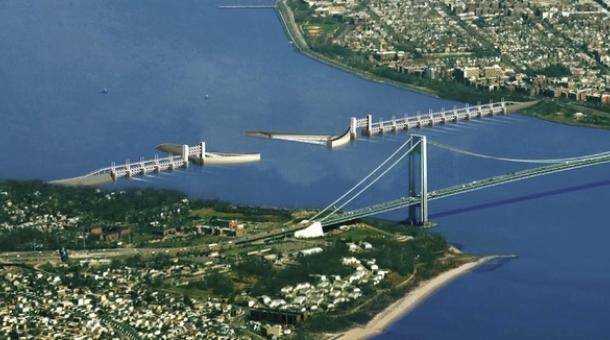January 10, 2013 - "NY debates expensive storm surge barrier"
By Mark Garrison, a NY-based Marketplace reporter and substitute host for the Marketplace Morning Report
Duration: 1 minute 33 seconds
SBU investigator Malcolm Bowman begins speaking at approximately 44 seconds into the broadcast

ARCADIS’ conceptual design of a surge barrier by New York’s Verrazano-Narrows Bridge. Courtesy of ARCADIS
New York is looking at the expensive possibility of putting a barrier system in its waterways, designed to prevent the next hurricane from being as deadly and devastating as Sandy. Governor Andrew Cuomo is expected to go public soon with the findings of a commission charged with evaluating ways to upgrade storm protection in anticipation of future threats.
A proposal getting a lot of attention would put a barrier parallel to the Verrazano-Narrows Bridge, which spans the gateway to New York’s harbor. Linking Staten Island and Brooklyn, it’s the bridge John Travolta’s character hung around in Saturday Night Fever.
“Something has to be done to protect that area,” says Dennis Kamber, a senior vice president in water management at the engineering firm ARCADIS. “A barrier is one proven way to accomplish that.”
ARCADIS designed a barrier concept for that spot a few years ago. Gates would open and close to allow commercial freight and recreational boats to pass through. The design would cost an estimated $6 billion to build.
Malcolm Bowman favors an even more expensive option. The State University of New York at Stony Brook professor coordinates the Storm Surge Group. He and his colleagues have looked at water barrier plans for New York for nearly a decade. He supports a longer barrier further out that could cost up to $20 billion.
“It’s expensive,” Bowman admits. “But if you compare it to the damage that Sandy created, it puts it in perspective.”
With some official damage estimates topping $80 billion, a barrier that could have stopped most of it would be well worth its high cost. But if a storm like Sandy doesn’t hit again for many generations, it would not be money well spent. Also, critics say a barrier could harm the environment and make storm surge worse in the areas immediately outside the barrier.
“People aren’t gonna be supportive of all of this because of all the negative aspects,” says Philip Orton of Stevens Institute of Technology.
A barrier system would come only after years of study and construction, so the debate is far from over.